- Books Name
- ACME SMART COACHING Biology Book
- Publication
- ACME SMART PUBLICATION
- Course
- CBSE Class 11
- Subject
- Biology
PTERIDOPHYTA
General characters of pteridophyta
They are most primitive vascular, flowerless, seedless, spore producing cryptogamic land plants. Commonly called vascular amphibians "or" botanical snakes. These are first successful plants on land. Evolutionarily these are first terrestrial plants to possess vascular tissues.
Term pteridophyta was given by Haeckel.
1. Dominant phase of plant body is a sporophyte.
2. Plant body is differentiated into true stem, leaves and roots.
3. Vascular tissues are present. They are of two types, xylem and phloem. In xylem , true vessels are absent. In phloem, companion cells and sieve tubes are absent. Instead, sieve cells are present. Secondary growth is exceptionally present in Isoetes and Botrychium.
4. On the basis of leaves pteridophytes are of two types. In megaphyllous plants, leaves are large in relation to stem and leaf trace is broken by leaf gaps, e.g., ferns. In microphyllous forms, leaves are small and receive a single unbroken leaf trace, e.g., club moss and horsetails.
5. Sporangia are associated with leaves called sporophylls. Meiospores are formed inside sporangia. In some cases sporophytes may form distinct compact structures called strobili or cones (Selaginella, Equisetum).
6. Spore on germination produces small, reduced, free living', independent, multicelled, non-vascular, haploid gametophyte. This thalloid gametophyte is called prothallus. These require cool, damp shady places to grow. Because of this restricted requirement and the need of water for fertilization are reasons due to which the spread of living pteridophytes is limited and restricted to narrow geographical regions. The development of gametophyte may be endosporic (inside the spore wall) or exosporic (outside the spore wall).
7. Sex organs are multicellular and jacketed. Number of NCC in archegonia may be one uninucleate (Selaginella) or one binucleate (ferns).
8. Sperms are flagellated. They require an external supply of water for swimming to reach archegonia. The chemical stimulus is provided by malic acid.
9. Embryo stage is present.
10. Heteromorphic or heterologous alternation of generation is present in the life cycle.
11. Pteridophytes are divided in four groups, viz., Psilophyta (Psilotum), Lycophyta (Lycopodium, Selaginella), Sphenophyta (Equisetum), and Pterophytai/Filicophyta (Dryopteris, Pteris, Adiantum, Salvinia).
12. True ferns are leptosporangiate members of Filicophyta and are most conspicuous of the pteridophytes.
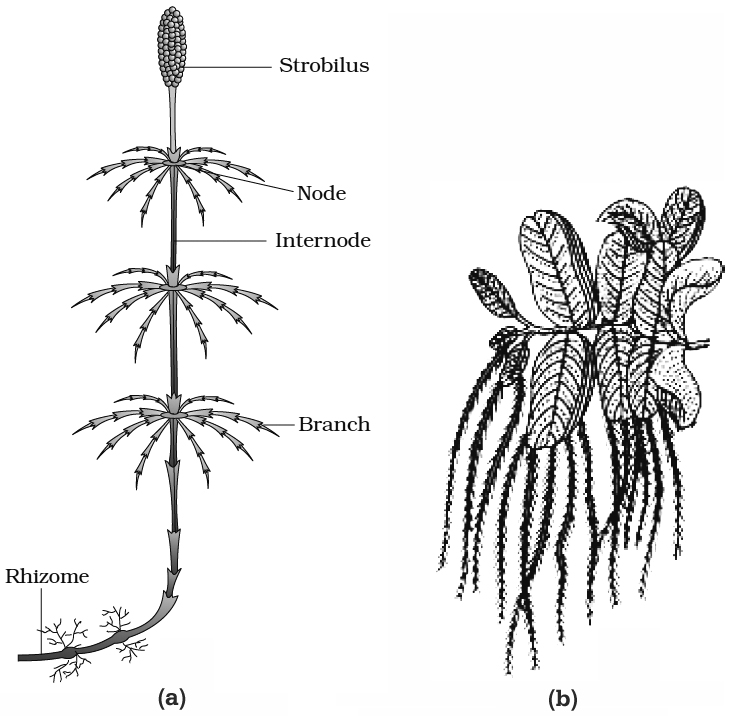
Concept Builder
1. Sporangium development is of two types in pteridophytes:
(i) Leptosporangiate -When sporangium develops from single superficial cell, e.g., Pteris, Dryopteris, Adiantum.
(ii) Eusporangiate -When sporangium develops from group of cells, e.g., Selaginella, Equisetum
2. Majority of pteridophytes produce same type of spores (homosporous, e.g., ferns like Adiantum, Pteris, Dryopteris). Only a few produce different types of spores, namely megaspores and microspores (heterosporous, e.g., Selaginella, Marsilea, Salvinia, Azolla etc.). Heterospory leads to seed habit in plants.
3. Embryogeny in pteridophytes is of two types:
(i) Exoscopic embryogeny : Axis of embryo is directed towards archegonial neck, e.g., Equisetum.
(ii) Endoscopic: Axis of embryo is directed inward towards venter, e.g., Selaginella.
4. Development of embryo may be :
(i) Holoblastic -When entire zygote is involved in embryonic development, e.g. , Ferns.
(ii) Meroblastic -When part of zygote is involved in embryonic development, e.g., Selaginella.
Stelar system
The central vascular cylinder of axis of pteridophytes is referred to as stele. It is a primary vascular tissue consisting of pith, xylem, phloem and pericycle.
It first appeared in pteridophytes like Rhynia. So lets study different types of steles proposed by Van Teigham and Douliot.
Types of stele :
1. Protostele: Simplest type, without pith
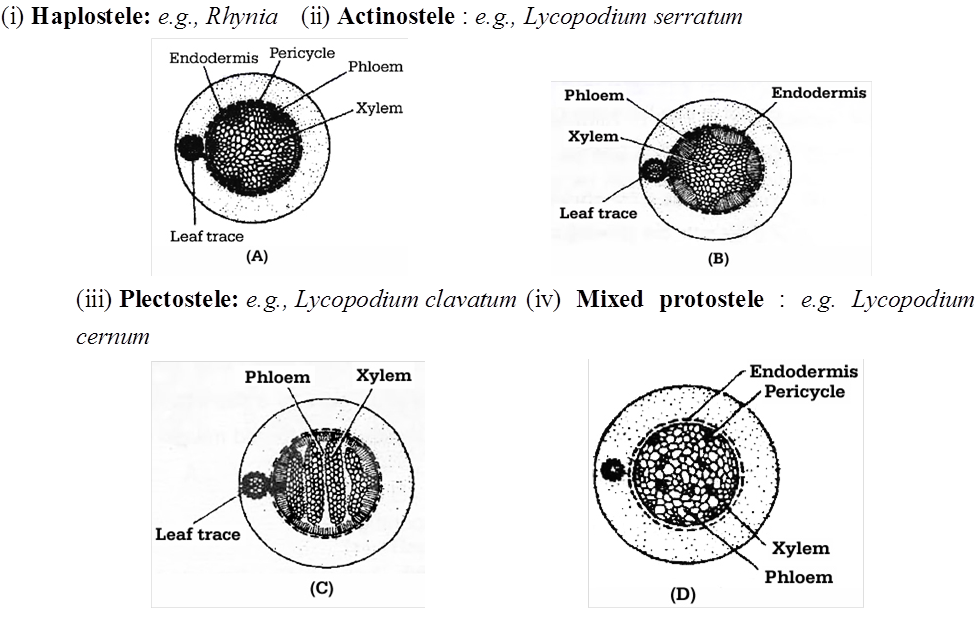
2. Siphonostele: With pith
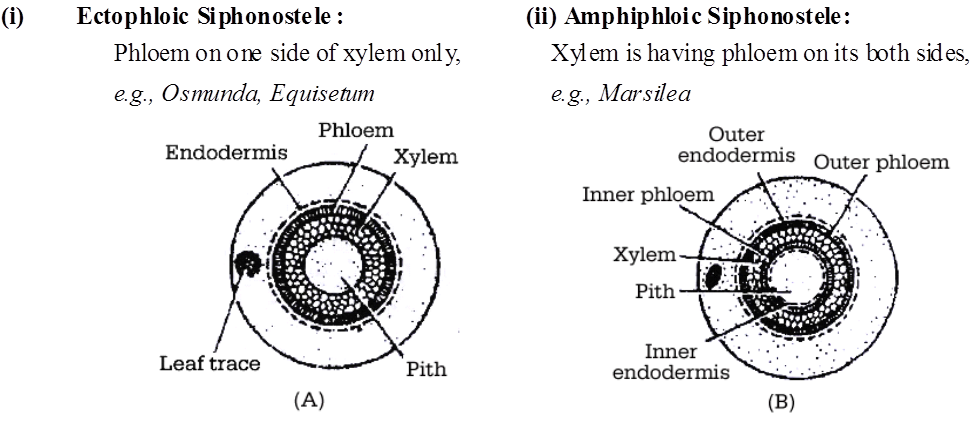
(iii) Solenostele : Stele with one or few non (iv) Dictyostele : Stele with large number of
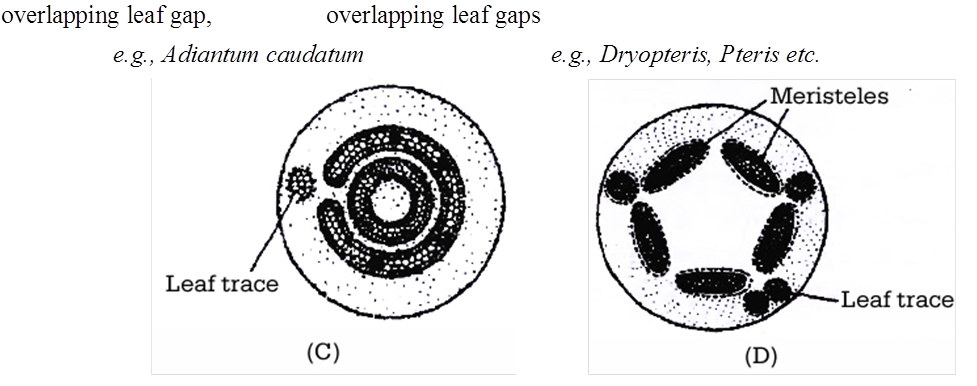
The specific features of true ferns are as follows :
i. The stem is underground rhizome (sometimes oblique, called root stock) in most of the ferns, except in tree ferns like Cyathea, Alsophyia where the stem is aerial.
ii. Leaves are large and are called fronds. Leaves may be simple or pinnately compound.
iii. Young leaves show circinate ptyxis, as they are coiled in the form of a watch spring. This coiling protects the growing point which comes to lie in the centre.
iv. Younger parts of stem, young leaves, petiole and rachis of mature leaves possess brown stiff hairs called ramenta. Ramenta protect them from mechanical injury and desiccation.
v. Sporangia occurs on the ventral surface of leaves in clusters called sori (singular-sorus). The fertile leaves are known as sporophylls. A sorus is covered by a flap-like outgrowth from its surface called indusium (true indusium, e.g., Dryopteris) or turned margin of the sporophyll (false indusium , e.g., Adiantum).
vi. Development of sporangium in true ferns is leptosporangiate.
vii. The male gamete is spirally coiled and multiciliated.
Life cycle of a fern (Dryopteris)
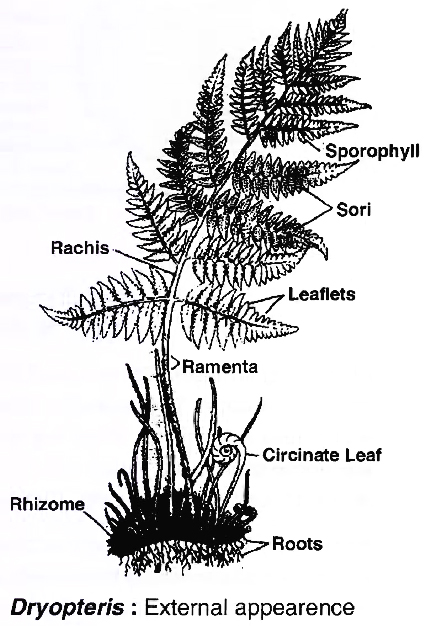
Plant body is a perennial, independently living evergreen sporophyte. It is differentiated into stem, leaves and roots. Roots are adventitious.
Stem is an underground dark brown rhizome.
The large aerial leaves or fronds develop acropetally in spirals from the upper surface of the rhizome.
The young leaves show circinate ptyxis. Persistent leaf bases of the dead leaves are found in older parts of rhizome.
Venation is open furcate in leaflets. Ramenta or paleae are present.
Reproduction
The fern multiplies vegetatively by fragmentation of rhizome and development of adventitious buds.
In Dryopteris, the adventitious buds present at leaf base separate and grow into a new plant.
In Adiantum caudatum and a few other species, adventitious buds develop at leaf tips.
When such leaf tips happen to touch the soil, they form new plants.
The process helps in spreading the fern over a large area. Because of this reason A. caudatum is also called walking fern.
Ventral surface of leaflets of a mature leaf bear yellowish brown clusters of sporangia called sori. The leaves having sori or sporangia are called sporophylls.
In Dryopteris, the sori develop in two rows, one on either side of the veins. Each row contains 4-6 sori. Each sorus is covered by a membranous sheath of its own.
This covering is called true indusium. The covered sori of Dryopteris are kidney-shaped in outline. This has given the name of male shield fern to Dryopteris.
A sorus consists of a parenchymatous cushion of placenta. The placenta bears a number of stalked biconvex sporangia. In each sporangium, there is a single layered jacket that encloses 12-16 diploid spore mother cells.
A marginal row of jacket cells are differentially thickened to form annulus. The remaining marginal cells constitute stomium. The diploid spore mother cells divide meiotically to form haploid spores.
With the maturity of spores, the indusium shrivels. The exposed sporangia dehisce in the region of stomium due to differential contraction of annulus. The spores are thrown away. They are dispersed by air currents.

A. Fern leaflet (Sporophyll) showing sori, B. V.S. Sporophyll, C. A Sporangium
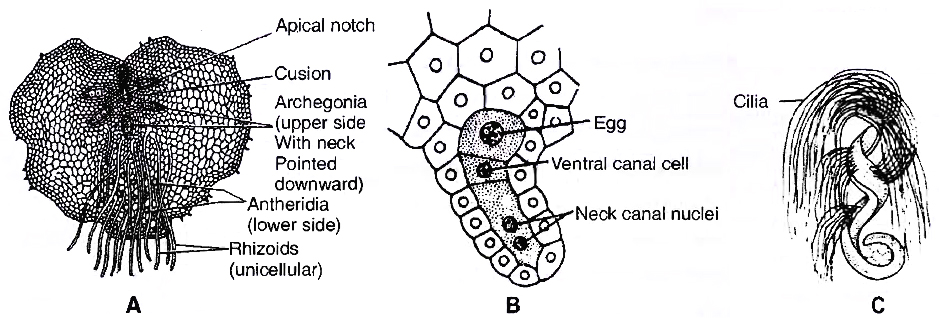
B. One archegonium C. One antherozoid
After falling on a suitable soil, each spore germinates to form a flat, heart shaped, green, thalloid gametophyte called prothallus.
The prothallus is monoecious, that is, it bears both the types of sex organs, male antheridia and female archegonia. They are borne ventrally.
Antheridia occur in the area of rhizoids, while archegonia are borne behind the apical notch in an area called apical cushion. Antheridium has a 3 celled jacket and about 32 sperm mother cells. The sperms are multiflagellate (= multiciliate) and spirally twisted.
Archegonium is flask-shaped in outline. It has an embedded venter and a projecting neck. Neck has 4-rowed wall which encloses a single binucleate neck canal cell.
The venter contains a single venter canal cell and an oosphere. In the mature state, the venter canal cell and the neck canal cells gelatinise. The neck opens.
Sperms are attracted to the opened archegonia by malic acid (chemotactic stimulus) present in their mucilage. A sperm fuses with an oosphere to form a diploid oospore.
The oospore gives rise to an embryo which grows in size to form the fern plant.
Life Cycle of Selaginella :
Salient features
Plant body is an evergreen sporophyte. It is differentiated into stem, leaves and roots. The roots often develop at the tips of special structures called rhizophores.
Plant body of Selaginella chrysocaulos and S.selaginoides is erect. Its leaves are isophyllous and arranged in two rows. In S.kraussiana the plant body is prostrate. Its leaves are anisophyllous or dimorphic and arranged in four rows.
Bower and Goebel named rhizophore of Selaginella as an organ sui-generis, i.e., an organ having the characters of both stem as well as root, but independent in origin.
The stem in Selaginella is distelic. 'Rarely stem is monostelic.
The plant body can multiply vegetatively by fragmentation, bulbils and tubers. Bulbils and tubers help in perennation as well.
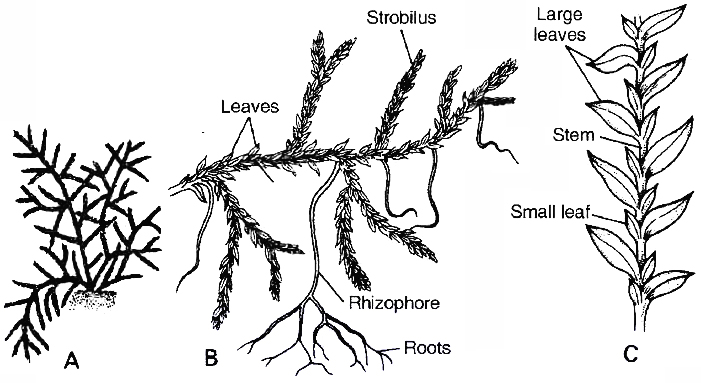
C. Arrangement of leaves
Sporangia develop in the axil of fertile leaves or sporophylls at the tips of small branches called spikes. There are two types of sporangia, microsporangia and megasporangia, hence this genus is heterosporous.
Each microsporangium produces a large number of small haploid microspores. A megasporangium develops only four haploid megaspores. Growth of the gametophytes is precocious.
Microspore produces an endosporic 13-celled male gametophyte. The latter has one prothallial cell, 8 jacket cells and four androgonial cells. The androgonial cells form 128-256 androcytes or sperm mother cells. A sperm mother cell gives rise to a biflagellate sperm.
Megaspore produces a partially exosporic female gametophyte. The female gametophyte contains an exposed generative apical cushion and a storage tissue. The two are separated by a
diaphragm
The apical cushion produces archegonia and rhizoids. Each archeogonium has a single female gamete or oosphere. The mucilage oozing out of neck of archegonium in Selaginella and fern contains malic acid.
The neck of archegonium in Selaginella and fern contains only one neck canal cell. Fertilization requires the help of external water for swimming of sperm. It produces diploid oospore.
Oospore divides to form a suspensor and embryo. The development of embryo is meroblastic. Suspensor helps in pushing the embryo into food laden storage tissue. Embryo has a foot for absorbing nourishment, a shoot tip and a root tip. The latter two elongate and produce an independent sporophytic plant body.
Selaginella shows two distinct generations, sporophyte and gametophyte, one producing the other. They are morphologically different. The phenomenon is called heteromorphic or heterologous alternation of generations.
Concept Builder
1. Common names Spike moss (Selaginella)
Bird's nest moss (Selaginella rupestris)
Club moss (Lycopodium)
2. Smallest pteridophyte =Azolla pinnata (an aquatic fern). It is commonly used as biofertilizer.
3. Largest pteridophyte = Cyathea (tree fern)
4. Apogamy : It is development of haploid sporophyte from gametophyte without fertilisation. It was reported by Farlow in Pteris cretica.
5. Apospory : It is development of diploid gametophyte from sporophyte without meiosis. It was reported by Druery in Athyrium. Due to apospory, polyploidy is common in ferns.
6. Psilotales like Rhynia (fossil) were first tracheophytes.
7. Psilotum shows presence of rhizoids and dichotomous branching of stem.
8. Under dry conditions, the xerophytic species of Selaginella roll into brown balls. The phenomenon is called cespitose habit. In this state, it may be uprooted. The brown balls become green and unroll again under moist conditions. Because of this characteristic, these plants are known as resurrection plants, e.g., S.lepidophylla, S.bryopteris.
9. Selaginella rupestris shows a near approach to seed habit.
Pteridophytes
A pteridophyte is a vascular plant that disperses spores and has xylem and phloem. Pteridophytes are frequently referred to as "cryptogams," meaning that their mechanisms of reproduction are hidden since they do not produce blooms or seeds.Horsetails and ferns are examples of Pteridophytes. Pteridophytes are utilized as soil binders and for therapeutic purposes. They're also commonly used as ornamentals. They are the first terrestrial plants to have vascular tissues – xylem and phloem – according to evolution. Pteridophytes prefer chilly, damp, shady environments, yet some can thrive in sandy soil.
Pteridophytes, have a sporophyte that is divided into real roots, stems, and leaves. The vascular tissues in these organs are well-differentiated. Pteridophyta leaves can be microscopic (microphylls) like Selaginella or huge (macrophylls) like ferns. Sporophytes have sporangia that are cared for by sporophylls, which are leaf-like appendages. Sporophylls can sometimes develop unique compact structures known as strobili or cones (Selaginella, Equisetum).In spore mother cells, the sporangia produce spores by meiosis. The spores germinate to form prothallus, which isa small, multicellular, free-living, primarily photosynthetic thalloid gametophyte. These gametophytes can only thrive in chilly, wet, shaded environments. The proliferation of live pteridophytes is limited and restricted to certain geographical locations due to this specific constrained requirement and the necessity for water for fertilization. Male and female sex organs, known as antheridia and archegonia, are found in gametophytes. The transmission of antherozoids — male gametes released from antheridia – to the mouth of archegonium requires water. The zygote is formed when the male gamete fuses with the egg contained in the archegonium.The zygote then creates a multicellular, well-differentiated sporophyte, which is the pteridophyte's dominant phase. The majority of pteridophytes have homosporous plants, which means that all of their spores are of the same type (e.g. Psilotum, Lycopodium, and Equisetum). Heterosporous genera include Selaginella and Salvinia, which generate two types of spores: macro (big) and micro (small). Megaspores and microspores, respectively, germinate and produce female and male gametophytes. Female gametophytes are kept on the parent sporophytes for varying amounts of time in these plants. The female gametophytes are responsible for the development of the zygotes into newborn embryos. This occurrence is a prelude to the seed habit, which is considered a crucial evolutionary step.
Pteridophytes are divided into four groups: Psilopsida (Psilotum), Lycopsida (Selaginella, Lycopodium), Sphenopsida (Equisetum), and Pteropsida (Dryopteris, Pteris, Adiantum).
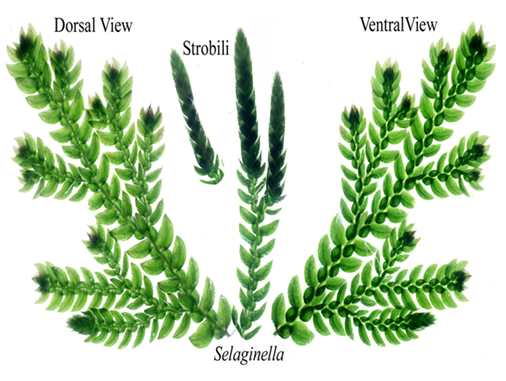
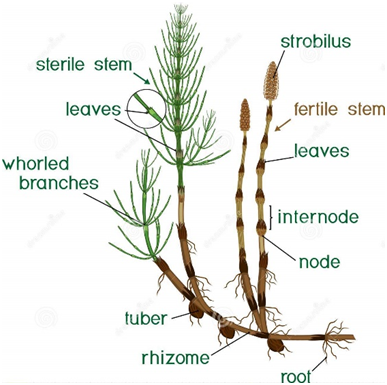
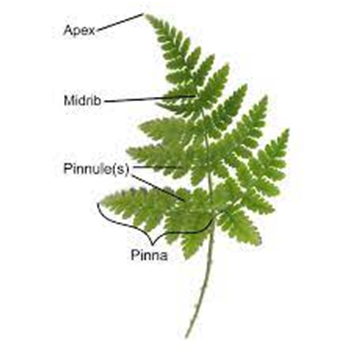
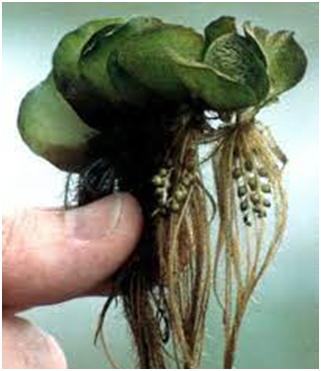
Figure 6

 ACME SMART PUBLICATION
ACME SMART PUBLICATION
